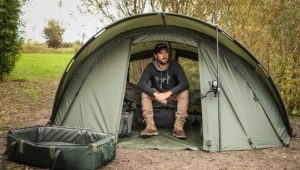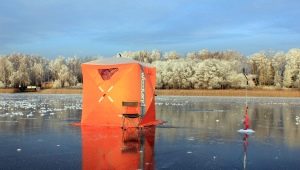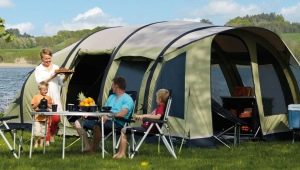Winter tents: features of choice and use

Camping in winter is very popular. But if people want to get away from the usual well-equipped resorts, they can not do without "camping houses". It's time to deal with the nuances of winter tents and find out how to choose them, how to use them correctly.

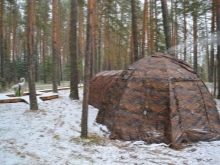
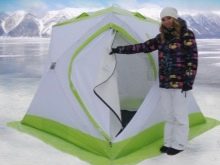
Peculiarities
In the summer months, quite a lot of people try to go hiking in the forests, in the steppes and even in the mountains. But if at this time you can take with you any equipment, then the winter tent is obliged to more serious in its execution.
A natural requirement is high strength. After all, even if the tent itself is warm, but it is easily damaged, it is impossible to talk about its practicality. In most cases, light fabrics made of synthetic materials are used when sewing, which absorb moisture in a small amount.
Specific characteristics are affected by:
- matter density;
- its thickness;
- the method used to weave the fibers.

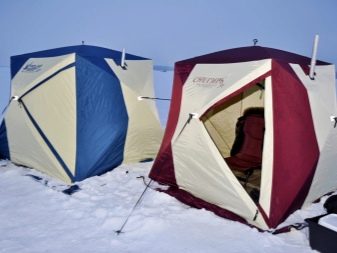
In some cases, even additional silicone or polyurethane spraying is used. In order for an insulated camping tent to fulfill its function in winter, it is given a special shape.Only structures that look like a cone or a sphere with many faces are quite effective in stopping the wind. Water resistance also plays an important role. The best tents are designed for a resistance of 6000 mm of water column, and the weakest - for 450 mm.
Copies sold to private individuals can accommodate from 1 to 8 people at a time. More capacious camp shelters are needed mainly by specialized organizations and are not sold on the open market.
It is also important to take into account that winter equipment can be designed not only for hiking, but also for hunting or fishing. Depending on this, specific requirements apply.

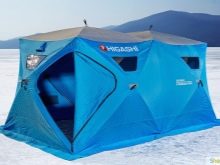
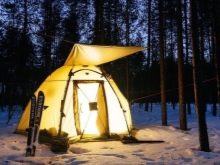
How are they different from summer?
Inexperienced travelers, hunters and fishermen may have two questions: what are the differences between tents used in winter and summer, and how to understand whether a particular tent can be used in cold weather or not. For comparison, take the products used by anglers. If they are intended for the winter period, then there will be no bottom below. Arriving at the right place, the fishermen will set up a tent directly on the ice or snow, making holes. But if the design is designed for many hours of parking and overnight stays, then the floor will be prepared below.

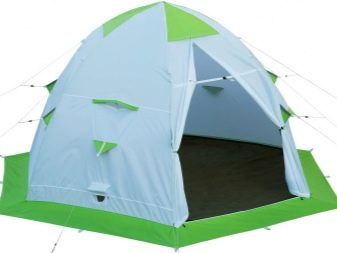
Modifications resistant to cold must also be designed with the expectation of installing a furnace. But there are no stoves without pipes - and therefore the developers have to provide a hole for them too. Most often, positions for fixing the focus are universal. Only in some models it is impossible to apply standard designs. But protection from rain with the help of an internal awning is impossible.
Despite the increased density of this structure, it is made "breathable", thereby providing ventilation. If you do not support the passage of moisture through the material, condensation may begin to form. Only the immediate outer layer (and even then under the condition of an air gap) can have a waterproofing function.
Universal for the season and summer tents are almost always distinguished by total moisture protection, while ventilation is provided by vents.
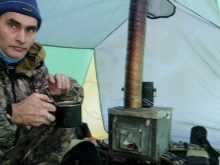

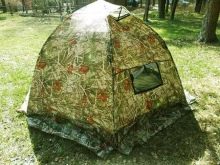
The “skirt” also helps to determine which product is where. This name was given to the auxiliary fabric at the very base. Such a ledge can be buried in a layer of snow, thereby improving the thermal characteristics of a temporary dwelling. Designed for installation in the cold, tents are shaped like a cube or sphere. These geometries provide the fastest opening and closing while meeting the basic requirements.
The design will open in much the same way as an umbrella. Installation usually takes no more than two minutes. But even this is not enough - winter tents usually strive to be as compact as possible. Heating a significant amount of air, even when using a camp stove, is very difficult. And without it, he is completely unattainable; the tent should keep warm in any situation.
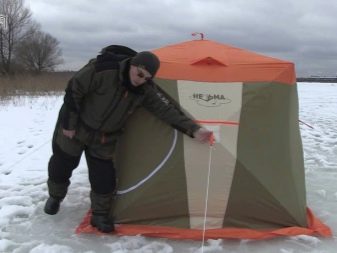

Kinds
But it must be borne in mind that in winter tents are set up for a variety of needs and tasks. Therefore, the designers had to create many varieties of such field "houses". So, for lovers of winter fishing, products such as "umbrella" or "cube" are most suitable. Umbrella tents are roomy and light, designed by default for automatic or semi-automatic installation. To start using such a fishing house, you only have to direct the frame elements in the right way.
It is allowed to leave the awning fastened. Stretching helps to make umbrellas more resistant to gusts of wind. Experienced people can install these stretch marks very quickly. In most cases, the "umbrella" is a regular hexagon, the walls of which are inclined at an angle of 45 degrees to the base. This design is not accidental - judging by experience, it allows you to cut through the wind, regardless of the direction from which it blows.
There is only one problem - the fishermen will have to sit strictly in the center of the shelter. It is impossible to straighten the back directly under the wall. The exception is umbrella tents for three people. But they are more expensive, bulkier and heavier than single-seat versions.
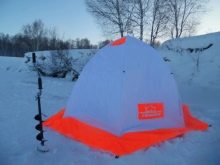
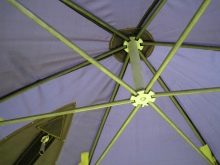
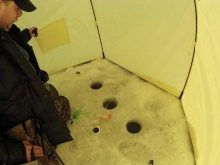
"Cube" is much nicer, from the user's point of view.
However, its main weakness is its significant exposure to the wind (sail, as the professionals say). It is necessary, in order to increase the stability of the product, to use materials of increased strength for the manufacture of the frame. This inevitably adds weight to the entire structure.
Important: the entry hole in the "cubes" is noticeably narrower than in the "umbrellas". The rhombic opening narrows at the top and at the base.


It is difficult to use such products without special skills. In addition, light warm air is collected at the top, and a heavy cold layer stagnates at the bottom. This problem is mainly solved by heating with candles or burners. But at the same time, other risks appear - a fire hazard, the accumulation of heated gases. For anglers it is very important to choose in any case a tent with a bottom and a floor.
Such elements will increase resistance to cold and make your favorite activity more comfortable. An equally important criterion is the number of layers that make up the tent. There are several options: single-layer, two-layer and three-layer design.
It may seem that the more layers, the higher the same protection from frost, from other adverse factors. In reality, the situation is somewhat different: adding additional layers makes the structure heavier.
And therefore, even if a residential tourist tent can be transported on a sleigh, and not carried in a backpack, it is still inappropriate to chase a thickening. If you look at affordable two-layer field dwellings for the mass consumer, they are too heavy. And lighter and well-thought-out designs are used mainly by climbers.
It is very expensive to acquire them for the main part of amateur travelers. The negative role of additional mass in single campaigns is especially great; in group exits, it begins to manifest itself clearly only after a rather long time.
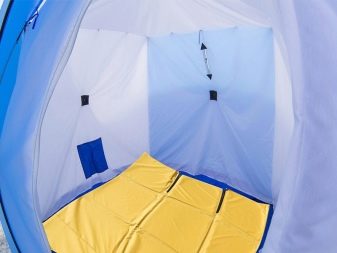

In terms of resistance to wind gusts, single-layer and multi-layer structures differ little. A much greater role here is played by the correct concept of the product itself and the literacy of its installation on the ground. Inflatable tents deserve special attention. This type can be used in automatic or semi-automatic mode. This property is especially appreciated by anglers who do not want to waste even a few minutes in vain.
But tourists should think three times before taking such a thing. The fact is that the inflatable structure can only be folded when it is completely dry. As soon as it gets wet, the materials begin to rot, while the service life is drastically reduced. Theoretically, it is possible to dry a tent at home, but in practice it may not survive even to the end of a long hike.
Automatic designs are inflated "themselves" due to a cartridge filled with a certain gas, and a semi-automatic circuit involves pumping.
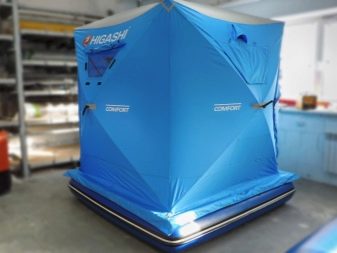
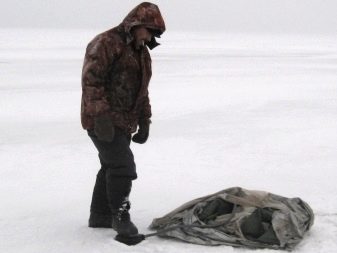
You can complete the review of the main varieties by indicating the classification of tents according to the type of reinforcement used. The first frame modifications appeared in the mid-1950s. There are two main options - metal-based and polymer-based. Recently, some companies offer tents with inflatable fittings. Important: it is hardly reasonable to purchase such products if you plan to go to an area often blown by strong winds.
If it is very important to choose a model that can be transported on a sled, you should take a closer look at the company's products. Eskimo. Yes, it sets a very high price, but the result justifies the investment. Among the three-layer structures, a prominent place is occupied by Pathfinder Cube Economy. Inside there is room for two people, and there are pockets for fishing accessories. A transparent polymer window helps to improve the illumination of the tent.
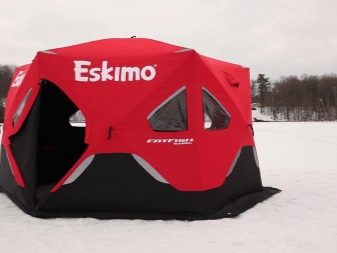
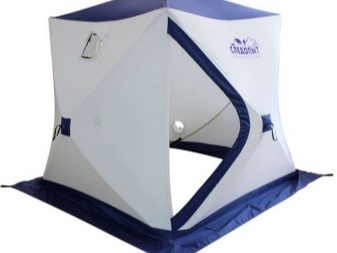
Popular Models
In addition to knowing the general classification of tents, you need to figure out which models are most suitable for practical use in Russia.
A good choice for many people "Ripus 2T". This design is designed for comfortable use by 1 or 2 fishermen. All tents of this series are equipped with three-layer awnings, while the layers are separated. This solution allows you to increase the resistance to cold to the limit.
The "Ripus" system implies the insulation of awnings with synthetic winterizer with a specific gravity of 0.2 kg per 1 sq. m. The largest version from this company is 4T. In it, without problems, they place:
- a couple of folding beds;
- table;
- chair.
Even with such an arrangement, organizing fishing and doing it comfortably is not difficult.
The mass of Ripus 2T is 15 kg, and its transportation dimensions are 135x0.3x0.3 m. The Ripus 3T weighs 17 kg, after installation its height is 1.9 m. In this case, the transportation dimensions will be 1.45x0.35x0, 35 m
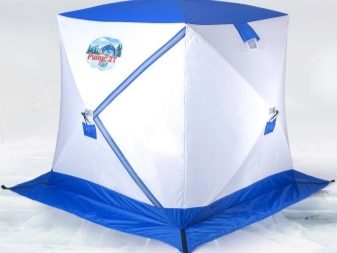
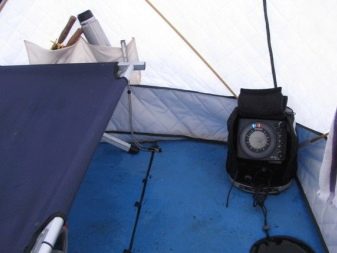
Many people consider brand products to be a good alternative. "Nelma". Under this brand, a lot of tourist goods and various accessories for work, recreation in the field and conditions close to them are produced. So, for lovers of winter fishing, Nelma-1 will definitely suit. Its dimensions are 1.4x1.4x1.5 m. Dural rods were used in the manufacture of the umbrella frame. All nodal connections are made of metal.
The fabric in "Nelma-1" is used with waterproof impregnation. The manufacturer guarantees resistance to 2000 mm of water column. The dimensions of the product are 1.4x1.4x1.5 m. The larger "Nelma-2" has a size of 1.9x2.25x1.6 m. The dry weight of this tent reaches 4.5 kg.
The largest "Nelma-3" has a size of 2.4x2.8x1.9 m. This product includes 6 knitting needles, and its total weight is 5.5 kg.
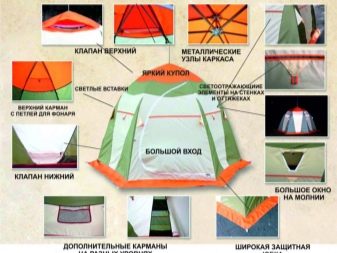
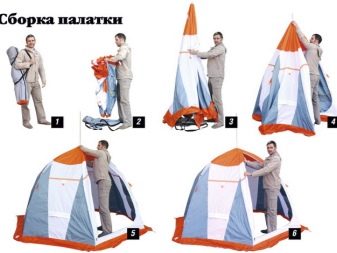
But if you pay attention to the best models in the latest ratings and reviews, then you can not ignore and "Lotus Cube 3 Compact Thermo". A similar design, according to the manufacturer, has a compact folding system. The description mentions that "Compact Thermo" appeared in 2018, and that its main advantages are:
- original thermal protection system;
- reliable waterproofing of the base;
- protection of the field shelter from the sun and precipitation.


Inside there is a frame made of glass composite of increased rigidity. Folding has been improved through the use of the latest development - a flexible locking knot.Light-conducting fabrics are used in the construction of the tent. The awning is divided into 3 layers separated by layers of air. This solution allowed us to simultaneously provide exceptional strength and excellent heat retention.
The equipment of the ice fishing tent meets the latest professional standards. The developers were able to create such a fastening system that provides installation:
- transparent windows;
- valves for heat exchangers;
- fire resistant valves;
- mosquito nets.
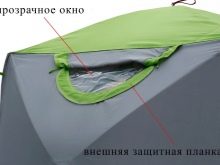

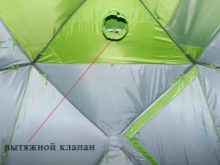
According to the manufacturer, it will be comfortable inside, even if there is a severe frost outside, accompanied by a wind close to a gale. The compression system will help to lay down a tent up to 0.3 m in diameter. A number of patents have been issued for the structural components of the model. Maximum compactness when folded is maintained by double folding of the lower arches. Without a flexible fixation node, this would not be possible.
You can fold the arc in a maximum of 2 seconds. To do this, you need to make a single movement. The arc inside the opening mechanism is attached in a hinged way.
Thanks to a special cotter pin, it became possible to reach the optimal strength-to-weight ratio. Not one competing model is capable of this.
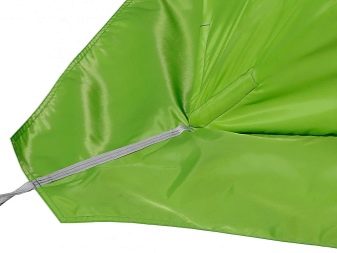
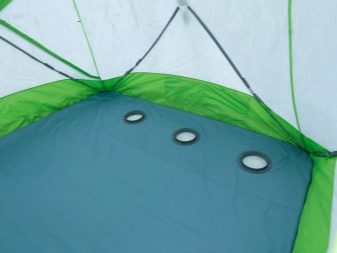
Some experts consider a tent an attractive alternative Yurta PRO. The company gives a 1-year warranty on this model, and its dimensions are 4.6x4.6x2.1 m. The design is designed for hiking trips, in which 6 to 8 people participate. They can easily fit inside in comfort (as far as this word is applicable to wilderness crossings). For insulation, a three-layer Thermal fabric is used.
As practice shows, this tent performs well in strong winds and significant frosts.It is also suitable for ice fishing. The designers took care of the possibility of using various heaters and stoves to improve the microclimate. Those who are going to spend the night in such a Yurta PRO are advised to additionally purchase a branded “foam” type floor. There is a hook for hanging flashlights, 4 mesh pockets for important documents, phones, walkie-talkies and the like.
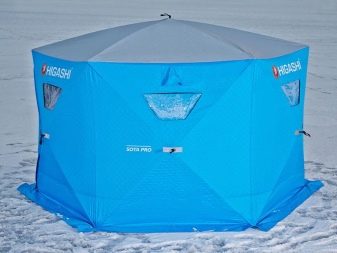
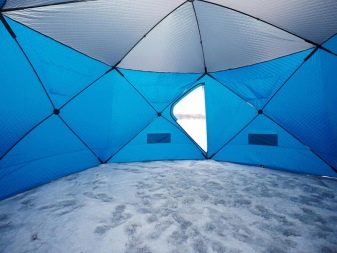
The same company Higashi can offer another model - Winter Camo Sota. The dry weight of the tent for 6-8 people reaches 19 kg. Its dimensions are 3.6x3.6x2.1 m. The unfamiliarity of the version lies in the fact that the developers deliberately abandoned the cubic form. The transition to a honeycomb performance has been highly appreciated by many fishermen, including those living in regions with harsh winters.
The height of more than 2 m is very attractive compared to other winter tents. Consumers can choose between sky blue and camouflage color solutions. The second option is suitable for hunters.
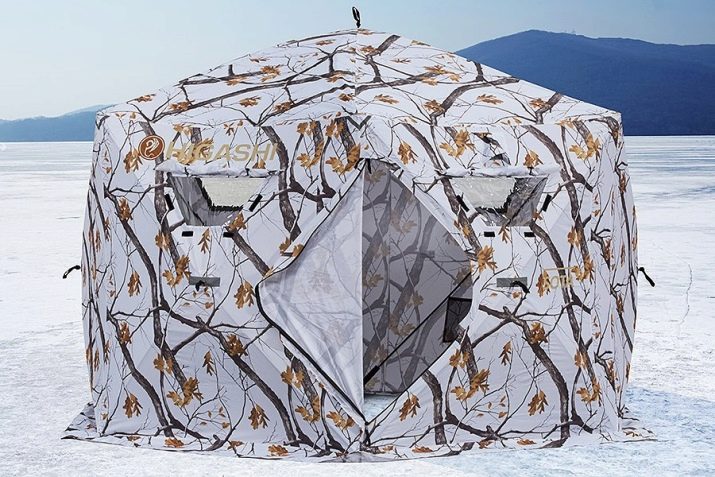
The next in the review of current versions will be a tent "Sakhalin 2". There are two main options - yellow and gray, both designed for two fishermen or tourists.
A high-quality Russian product has a size of 160 x 160 x 170 cm. The manufacturer guarantees that the awning has a water resistance of at least 2000 mm.
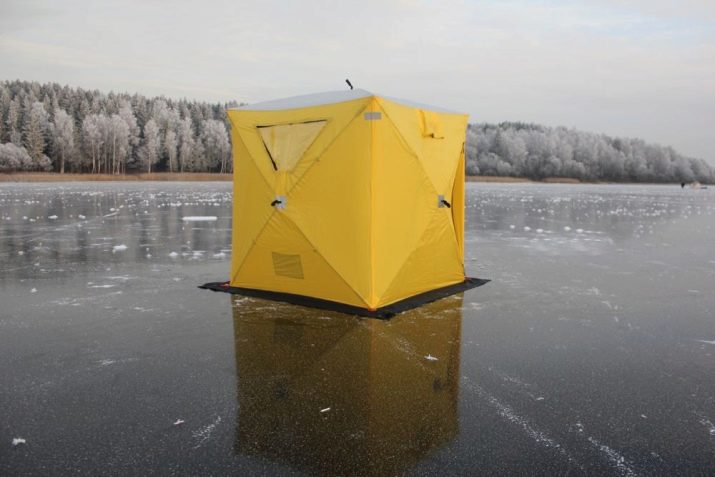
Quite a few prefer the version Holiday Easy Ice. The mass of this tent reaches 2.5 kg, it is painted only in yellow. The single-layer rigid fiberglass assembly is disassembled and transported in bags without any problems.
Special hooks will allow you to secure the field house to the edges of partially drilled holes. The height of the internal volume reaches 1.5 m. The manufacturer guarantees water resistance of at least 600 mm. Other dimensions 1.8x1.8 m.
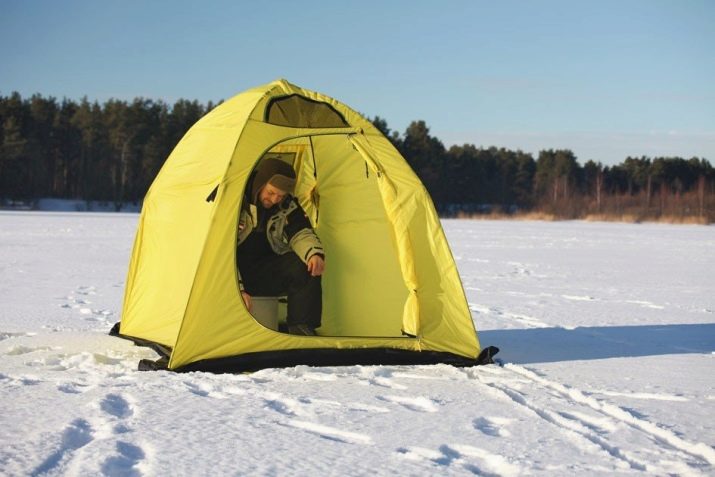
How to choose?
In most cases, tents for camping, as well as for fishing, are made of synthetic materials. There is no need to be afraid of this - such substances have repeatedly confirmed their excellent qualities. They were originally used in the military and other special areas. The main thing that is required from buyers is to carefully study the labeling and accompanying documents. Experts note that the best fabrics for the winter period are lavsan and polyester.
Important: taking a very large tent is not recommended. Even if it is needed only for fishing, it will take up extra space in the car. All the more badly, such a product will turn out to be hiking in difficult terrain, where literally a single gram is important. But at the same time, it is undesirable to take too small products.
It is necessary to focus on such structures that will allow you to accommodate for an overnight stay with comfort for everyone who needs it.

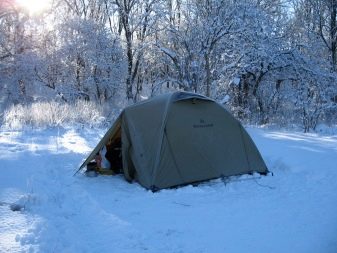
In any case, it is worth asking how the threads are intertwined. The highest strength is achieved using the ripstop method. But in most mass-produced designs, the “taffet” technique is used. She also proved herself on the good side, although she is inferior to the “ripstop”. The density of matter is displayed in special digital notation; The marking also contains information about the substances used for impregnation.
Among the tent structures themselves, experts consider the frame version to be the most reliable. If everything is done correctly when setting up camp, extraordinary stability is guaranteed. However, you will need to install the tent manually, which is very difficult in frost and wind. And yes, it will take a lot of time.
For tourists who would like to go more along the route, reducing parking time, this disadvantage is very serious.
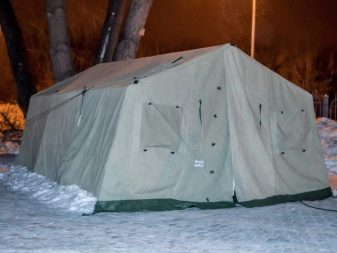
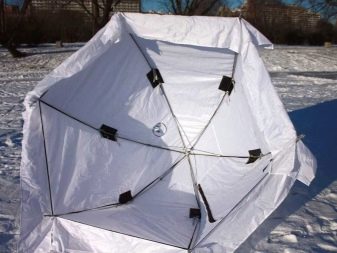
Fishermen should also consider this. Frame tents will perform well only when fishing will often last for several days. A more modern option is trekking field houses. They are light (no more than 5 kg) and can accommodate 2-4 people. The special structure of the frame with crossed arcs greatly simplifies installation and disassembly.
Trekking structures are always made of the strongest and most reliable material. It will effectively cover people from gusts of wind, and from snow, and from rain. In any case, it is unreasonable to save on the purchase of a tent. Models made in China and other Asian countries are still inferior to Russian and European products. Their only real advantage is their democratic price.
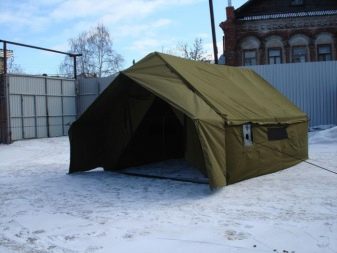
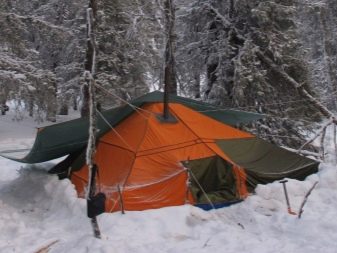
You also need to think about the color of the tent. Bright models are easy to spot from a distance or from a height. This is very important in the event of an emergency. White and other light colors are not very popular because of the soiling. The main part of consumers (both tourists and fishermen, hunters) prefers camouflage tents.
Fishing enthusiasts should definitely take a closer look at the so-called carp tents. They are optimized for long-term fishing with 1-2 fishermen. A design feature is the attachment of an awning to a rigid frame. For the cold period, carp tents with two-layer walls and a retractable bottom are used. A very useful addition is a cape that increases resistance to cold.

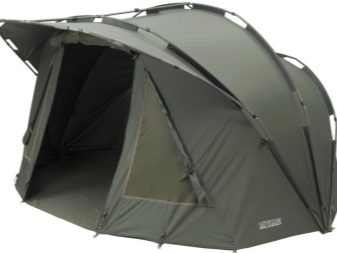
Additional heating
It is often recommended to take it with you on the road. a bath stove of an industrial or home-made design. Such a solution is quite effective, but many furnace designs are cumbersome. In addition, you need to take care of ventilation and removal of combustion products of fuel in advance. The simplest method of obtaining heat is big candle. In this option, an equipped chimney will not be required, and if the frost does not reach 15 degrees, then it will be possible to solve the heating problem completely.
You can also use dry fuel. His pills are burned in empty cans.
Alternative solutions are:
- compact gas burners;
- heterogeneous tourist burners;
- burners for gasoline;
- blowtorches;
- infrared heating devices.


Operating rules
Consider now how to set up and assemble such a tent.
Installation
Any tent is important to use correctly. Experienced people open it by standing against the wind. At the same time, the entrance is kept open so that the air stream helps, and does not interfere.
It is categorically impossible to apply excessive force if something does not work right away. It is especially risky to put pressure on rivets and wire fasteners.
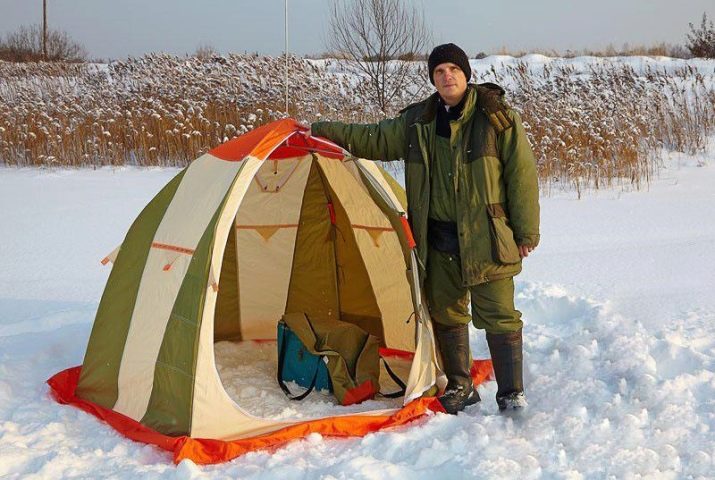
Assembly
The cover where the tent is packed must be of sufficient size. And this means that it normally exceeds the dimensions of the folded product. After several hours or even days of operation, the fabric becomes covered with snow and condensation, its stiffness increases. Putting a wet and dry tent inside is not the same thing. But before exploiting and even more so folding the tent, it must be assembled.
If the structure has an internal frame, then proceed as follows:
- line the inside on the ground;
- having collected the arcs, insert them into the eyelets;
- hang a ceiling element on hooks (the easiest way is from top to bottom from one hook to another);
- put up an awning;
- fix it on the tips of the arcs;
- if required, slightly tighten the retaining straps.
Assembly and disassembly of the Stack winter tents, see the following video.
Reviews
In conclusion, it is worth considering how consumers evaluate various tent structures. Ripus products show their best side. It is noted in a number of comments that at a temperature of -7.8 degrees there is no special need for additional heating. On the upper mesh, it is convenient to dry wet personal items. The cover is rated approvingly, many people write about its reliability.
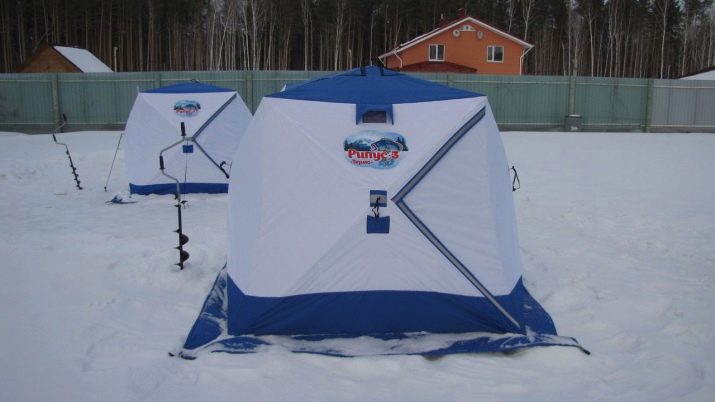
But sometimes they indicate that the outer pockets for the lines are not too necessary, and the lines themselves are excessively long. The constructions of the company "Nelma" are of high quality and comfortable; while in the reviews they write that for one person they may be unnecessarily large. Open flames can be dangerous. Thermal insulation at a decent level - in sunny weather it gets hot inside. Without the use of additional stretch marks, the Nelma tent, judging by the reviews, can be safely set up with a wind of 8-10 m / s.

"Lotus Cube Thermo" fully justifies its name. This model, indeed, protects those inside from hypothermia. Heating, if needed, is only at the very minimum level. The equipment is also positive. The only possible difficulty is the difficulty of carrying it alone.























